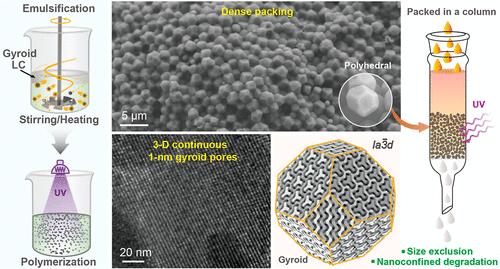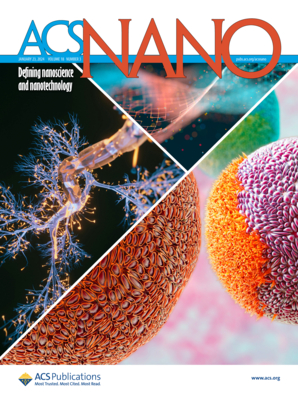Polyhedral Polymeric Microparticles with Interwoven 1 nm Gyroid Pores for Precise Adsorption and Nanoconfined Degradation
IF 15.8
1区 材料科学
Q1 CHEMISTRY, MULTIDISCIPLINARY
引用次数: 0
Abstract
Molecular-scale adsorption, catalysis, and separation demand nanoporous materials with high permeability, extensive surface areas, and pronounced nanoconfined effects. Fabricating polymeric particles with 3-D interwoven pores of ∼1 nm potentially addresses these needs. However, significant challenges remain in controlling their pore interconnectivity, uniformity, and achieving faceted particle shapes. Herein we present facile fabrication of polyhedral particles possessing interpenetrating 1 nm pores by suspension polymerization of double-gyroid (DG) liquid crystalline droplets. Mechanical stirring of the disordered phase at elevated temperatures, followed by undercooling, leads to the emulsification of DG droplets, as confirmed by synchrotron small-angle X-ray scattering (SAXS). UV-induced cross-linking of the DG droplets preserves the ordered network of 1 nm pores, as characterized by SAXS and microscopy. Intriguingly, due to the elasticity induced by the Ia3̅d periodicities, these particles adopt polyhedral shapes to avoid the elastic energy penalty associated with conventional sphericity. We demonstrate that these faceted particles, featuring 1 nm pores and efficient packing, enable rapid, size-exclusive adsorption and nanoconfined degradation of organic pollutants, driven by their 3-D permeability, high surface area, and enhanced nanoconfinement effects.

求助全文
约1分钟内获得全文
求助全文
来源期刊

ACS Nano
工程技术-材料科学:综合
CiteScore
26.00
自引率
4.10%
发文量
1627
审稿时长
1.7 months
期刊介绍:
ACS Nano, published monthly, serves as an international forum for comprehensive articles on nanoscience and nanotechnology research at the intersections of chemistry, biology, materials science, physics, and engineering. The journal fosters communication among scientists in these communities, facilitating collaboration, new research opportunities, and advancements through discoveries. ACS Nano covers synthesis, assembly, characterization, theory, and simulation of nanostructures, nanobiotechnology, nanofabrication, methods and tools for nanoscience and nanotechnology, and self- and directed-assembly. Alongside original research articles, it offers thorough reviews, perspectives on cutting-edge research, and discussions envisioning the future of nanoscience and nanotechnology.
 求助内容:
求助内容: 应助结果提醒方式:
应助结果提醒方式:


